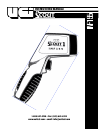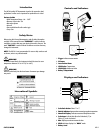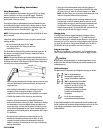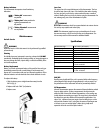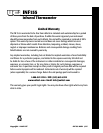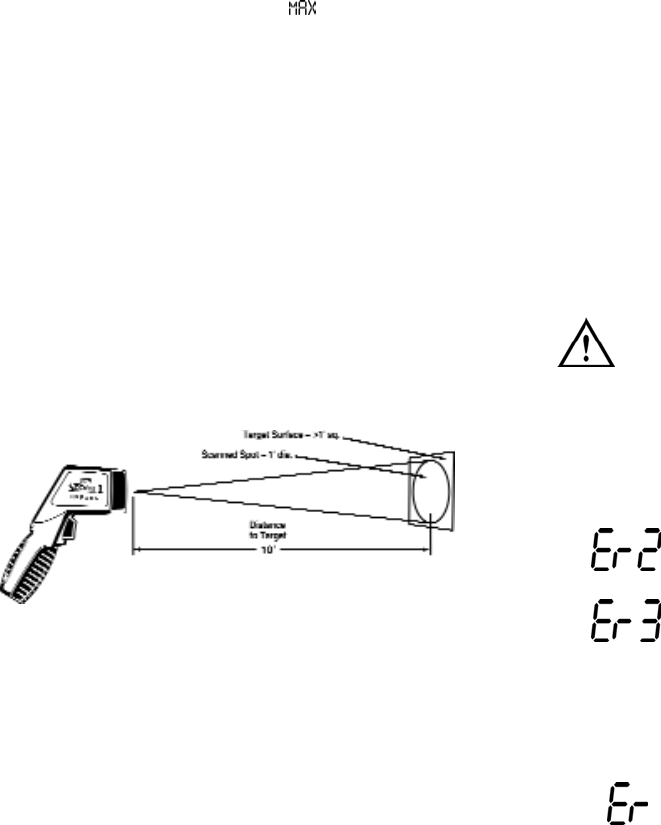
• Keep your infrared thermometer away from strong electrical
fields. When working near a strong electrical field, like that under
the hood of your car, watch for unusual readings or an "over
load" indication. Often, you can move the thermometer just a few
inches to escape the influence of the interference.
• Keep your INF155 within its use and storage temperature range.
Excessive heat or cold will adversely affect the accuracy of your
readings. When the trigger is pulled the target’s temperature will
be displayed in a near real-time mode (less than 1/2 second
between measurements). The temperature will remain on the dis
play for sixty seconds after the trigger is released.
Changing Scales
To change scales between degrees Fahrenheit and degrees Celsius,
press the button on the panel, (marked °F / °C), while the display is
active. Even if the trigger is released and the display is in its 60-second
automatic hold, you can convert the reading between scales. Each time
you press the scale button, the 60-second hold will reset. The INF155
will default to the scale last used the next time it is turned on.
Using the Laser Sight
The INF155 is classified as a "Laser Product", and is regulated by the
FDA. The laser and backlight are always on when the trigger is pulled.
CAUTION!
Using controls, making adjustments, or performing pro c e d u r es in any
manner other than that specified herein may result in hazardous laser
radiation ex p o s u re .
LCD Error Messages
The thermometer incorporates visual diagnostic messages as follows:
: “E r 2 ” is displayed when the
thermometer is exposed to rapid
changes in the ambient tempera t u r e .
: “E r 3 ” is displayed when the ambient
t e m p e rature exceeds the operation
range of 32˚ to 122˚F (0˚ to 50˚C). The
thermometer should be allowed
p l e n ty of time (minimum 30 minutes)
to stabilize to the working/room
t e m p e ra t u r e .
: For all other error messages it is
n e c e s s a ry to reset the thermometer.
To reset the thermometer, turn the instrument off, remove the battery and
wait for a minimum of one minute. Reinsert the battery and turn it on. If the
error message remains please contact UEi service department for
further assistance.
Operating Instructions
Taking Measurements
To take a temperature measurement using your INF155, you simply
point the aperture at an object and pull the trigger. The object’s
temperature will show up on the display and update at a rate of
approximately 2 times per second.
There will be a delay of approximately one-second between the time
you initially pull the trigger and the time the display comes on. The 60-
second auto-hold initiates at the moment you release the trigger. The
m a ximum temperature is viewed beside the “ “ icon.
NOTE: This thermometer will automatically shut off if left idle for more
than 15 seconds.
Follow these general guidelines to ensure you get the most accurate
readings possible:
• Be sure the measured object fills the "spot"
seen by the aperture. The distance to spot ratio
for the INF155 is 10:1.
This shows the one-foot spot fitting within the one-foot target area. At
this distance, and anything closer, the target’s temperature will be
accurately measured (Fig 1).
NOTE: If the two-foot diameter spot includes unwanted objects in the
background that are not part of the one-foot target, the temperature of
the background objects will be figured in with the target’s temperature
and cause errors in your measurements.
• When comparing temperatures of similar objects that are far away,
take your measurements at the same distance and angle to the
target each time.
• When looking for abnormally hot or cold targets it may be
acceptable to include background objects so long as the
temperatures in the background and your methods are consistent.
• Consider the emissivity of the objects you are measuring.
• Prepare a surface for measurement. Infrared thermometers
measure only the outer surface of an object. If emissivity is affecting
the measurement, or you have difficulty putting the object in the
sensors line-of-site, you may need to prepare a surface that’s easy
for the infrared thermometer to read. A piece of masking tape is a
good target and it will rapidly take on the temperature of the object
it is attached to.
• Be aware that you cannot measure the temperature of air
between the Infrared thermometer and an object. Air vents
(registers) are quick to take on the temperature of outlet air.
However, you must aim directly at the vent if you are measuring
outlet air temperature.
INF155-MAN P. 2
(Fig 1)



